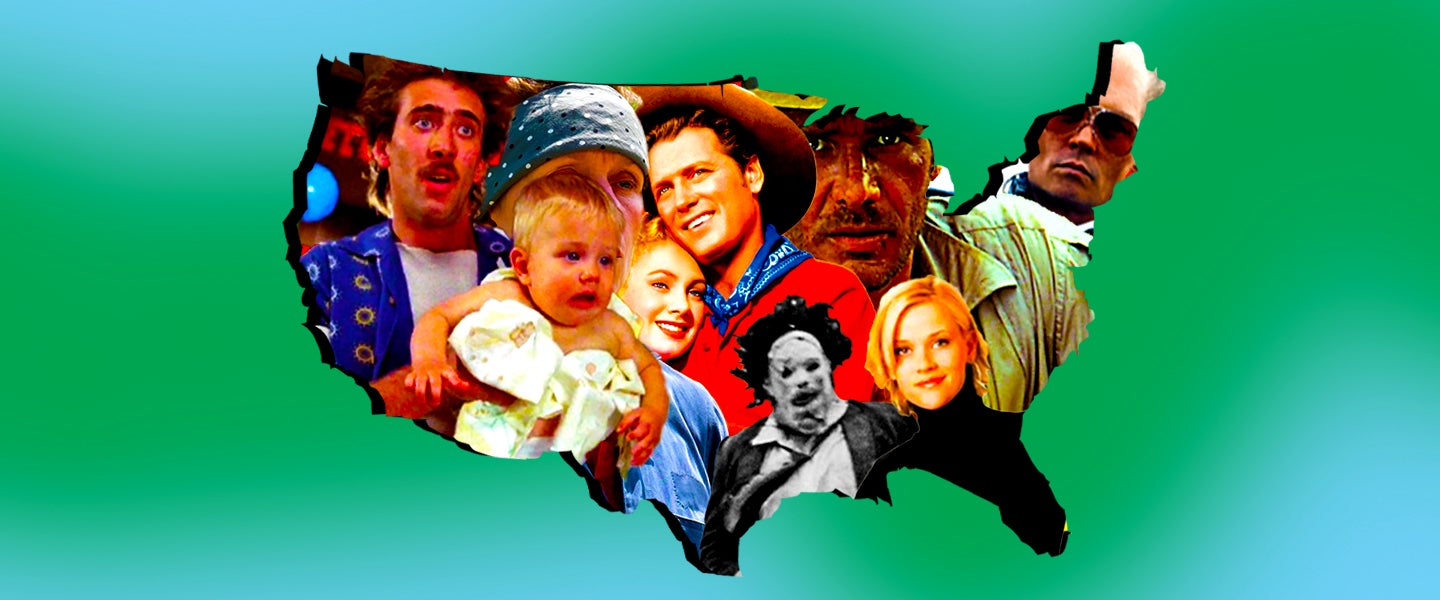Next week — on May 5th — most major digital retailers will begin carrying the VOD movie Arkansas, the directorial debut of actor Clark Duke, starring Duke and Liam Hemsworth as low-level lackeys for a drug kingpin, played by Vince Vaughn. The film is based on the John Brandon novel of the same name, the title of which probably appealed to Duke because he himself was born and raised in the Natural State.
The arrival of this movie made us wonder: As of right now, is Arkansas the best movie with “Arkansas” in the title? The competition there is meager, if we’re being honest. But what about the more competitive states? New York? Texas? California? What are the best movies with their names in the title?
What follows is a state-by-state pick for the best movies that features a state’s name — mostly in full, but in a few cases just in part. Sometimes we had to get creative, to make sure every state had a halfway decent representative. Please note that these films don’t have to be set in their states, or be about them in any way — although that certainly is a point in their favor.
With that in mind, here is our own United States of Cinema. Motto: “E Pluribus Kino.”
Alabama: Sweet Home Alabama (2002). Let’s start with something light and likable: a romantic comedy with a winning Reese Witherspoon performance, which honors the actress’ own Southern roots. As a bonus, the title “Sweet Home Alabama” would also win this category if we were naming the best songs for each state.
Alaska: North to Alaska (1960). The further west we get on the map, the more often the best options are westerns — typically starring Roy Rogers, Gene Autry or John Wayne. North to Alaska happens to be a fun Wayne picture, about squabbling turn-of-the-century prospectors making the most of the boundless opportunities in this untamed land.
Arizona: Raising Arizona (1987). There’s actually a decent pool to draw from with “Arizona,” including a fun recent neo-noir (2018’s Danny McBride-starring Arizona) and a zesty Sam Fuller picture (1950’s The Baron of Arizona). But c’mon. If we were ranking all the movies named after states, this Coen Brothers’ caper comedy would easily be in the Top 5. There’s what’s right and there’s what’s right and never the twain shall meet.

Arkansas: Arkansas (2020). We promise that this pick isn’t a case of recency bias. And we didn’t go for it just because most major motion pictures with “Arkansas” in their name tend to be dire cornpone comedies. No, this Southern-fried crime movie is genuinely entertaining, and in its own screwy way, it reflects both the absurdity and the darkness of the modern South.
California: California Split (1974). Though he lived in L.A. for most of his adult life, Robert Altman only made a small handful of films set in contemporary L.A., and nearly every one of them (The Player, The Long Goodbye, A Perfect Couple, Short Cuts) is brilliant. The best of the bunch is California Split, a shaggy story about two compulsive middle-aged gamblers, who’ve become unsettlingly comfortable with their roles as “colorful characters.”
Colorado: Colorado Territory (1949). Most movies with “Colorado” in the title are also normally westerns, and Colorado Territory is no exception. This one’s a little different, in that it’s actually a remake of a gangster picture, High Sierra. Both versions were directed by Raoul Walsh, and both are quite good. In terms of the overall “Colorado” contest, Colorado Territory has the advantage over its rivals in that it’s both set in Colorado and features a character named Colorado.
Connecticut: Christmas in Connecticut (1945). Were you maybe expecting a haunting? Or a yankee in King Arthur’s court? Sorry folks; the best Connecticut movie stars Barbara Stanwyck as a popular newspaper columnist who has to pretend to be a small-town housewife for her fans. Although to be fair, if the ghost of Stanwyck had appeared in The Haunting in Connecticut, that film would’ve won.
Delaware: 12th & Delaware (2010). The second-smallest state and the first to ratify the U.S. Constitution is poorly represented in the movie-titling business. How poorly? This very good documentary about an abortion clinic and a pregnancy crisis center — both located on the same block — is set in a small city on the east coast of Florida. It’s not a “Delaware movie” per se, but it’s the best with “Delaware” in its name.
Florida: The Florida Project (2017). Unlike Delaware, Florida’s pretty well-represented in movie titles. There’s a strong argument to be made here for Errol Morris’ freaky 1981 documentary Vernon, Florida, which introduced the concept of “Florida Man” long before Twitter. But Morris’ doc is only about an hour long, and besides, The Florida Project is another great movie about a complicated state, where low-income residents rely on the touristy fantasy of sunshine, beaches and amusement parks to eke out a living.
Georgia: Georgia (1995). The “Georgia” in question here isn’t the state; it’s a folk-rocker named Georgia Flood (Mare Winningham), who became a star right before the Lilith Fair era. And Georgia isn’t even about that character, it’s about her sister Sadie (Jennifer Jason Leigh), a self-destructive roots-rocker. Still, this is a fine movie, an unjustly forgotten slice of 1990s pop culture featuring some great music and one of the best performances of Leigh’s remarkable career.
Hawaii: Blue Hawaii (1961). Runners-up here include the epic 1966 adaptation of James Michener’s novel Hawaii and Andy Sidaris’ violence- and nudity-filled 1987 action picture Hard Ticket to Hawaii. But just as North to Alaska was an attempt to capitalize on the public fascination with a then-new state, so the Elvis movie Blue Hawaii was meant to introduce mainland Americans to their newly minted fellow citizens. This is also one of the best Elvis pictures, featuring picturesque scenery and a good performance by the King as an Army vet getting re-acclimated to his changing island home.
Idaho: My Own Private Idaho (1991). Here’s another obvious choice. Although the arty 1999 indie Twin Falls Idaho has its moments, Gus Van Sant’s offbeat Shakespeare adaptation My Own Private Idaho — with Keanu Reeves and the late River Phoenix as road-tripping hustlers in the American Northwest — is one of its decade’s standout films, and is part of the Criterion Collection to boot.
Illinois: Abe Lincoln in Illinois (1940). Most of the best Illinois movies are named for Chicago (like, well, Chicago). That’s one more reason to give thanks for Honest Abe: He inspired Robert E. Sherwood’s Pulitzer Prize-winning play about Lincoln’s rise to the presidency, covering his time as a young lawyer and politician in the Prairie State. That play in turn led to this film, with a perfectly cast Raymond Massey in the lead.
Indiana: Indiana Jones and the Last Crusade (1989). Because we refuse to call the first film in the Indiana Jones series Indiana Jones and the Raiders of the Lost Ark, the third one is actually the best one with “Indiana Jones” in its original title, which automatically makes it the best “Indiana” movie. That’s just logic.
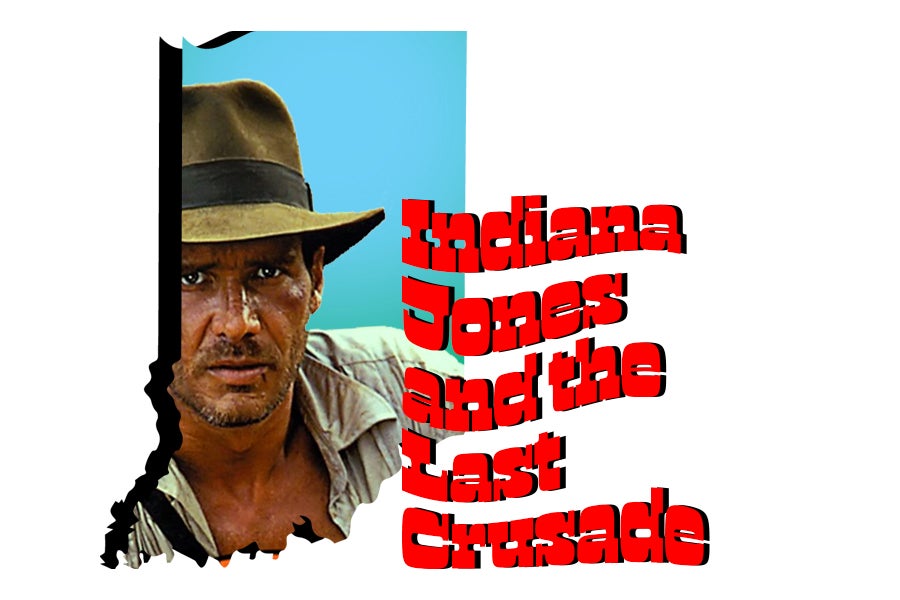
Iowa: Iowa (2005). Can we pass on this one? There are actually a fair number of indie films and documentaries with “Iowa” in the title but most of them are marginal and hard to find. By default, the pick here is this relatively prominent low-budget crime film, which had a decent-sized theatrical and home video release over a decade ago. It’s not great, but at least writer-director-star Matt Farnsworth does try to say something serious about the meth trade in middle America.
Kansas: Kansas City Confidential (1952). Although location itself is only one determining factor in this survey, we still hesitated before picking a “Kansas City” movie to represent “Kansas,” because people in that part of the country love to point out that most of what the general public associates with Kansas City is actually located in Missouri… and that includes the mid-20th century crime syndicate at the center of this classic heist picture’s plot. That said, most of Kansas City Confidential takes place at a Mexican resort, where a patsy plots his revenge against the mob. Also, this film is awesome.
Kentucky: The Kentucky Fried Movie (1977). Before Airplane and The Naked Gun, the comedy team of Zucker-Abrahams-Zucker wrote this hilarious anthology of spoofs, and — in a nod to their former Wisconsin-based improv troupe “Kentucky Fried Theater” — gave it a fast-food-inspired name, to evoke its unabashed trashiness and mainstream appeal. Colonel Sanders apparently didn’t object… although, to be fair, by then he had sold most of his interests in the restaurant chain and was spending his remaining days complaining about how its product had gone downhill.
Louisiana: Louisiana Story (1948). A classic of ethnographic cinema from the pioneering documentarian Robert J. Flaherty, Louisiana Story combines a fictionalized look at daily life on the bayou with what amounts to a promotional push for Standard Oil’s drilling operations. Flaherty’s ultimate message may be mixed (or just compromised by corporate sponsorship), but his craft and storytelling are superb, and his curiosity about Cajun culture is clearly heartfelt.
Maine: Five Nights in Maine (2015). This melancholy indie drama didn’t draw a lot of attention once it graduated from the film festival circuit, but it features quietly powerful lead performances from David Oyelowo and Dianne Weist, playing in-laws who have to overcome their differences so they can pay proper respects to the recently deceased woman who brought them together.
Maryland: Maryland (2015). This atmospheric French thriller was called Disorder when it was released in the U.S., but the original title is Maryland, so we’re counting it. Whatever the name, it’s worth seeking this movie out to see the magnificent Matthias Schoenaerts playing a troubled military veteran hired to look after a rich socialite (played by Diane Kruger).
Massachusetts: Black Mass (2015). How is it that Massachusetts — Massachusetts — has so few decent movies named after it? Is it because it has too many letters for the marquee, or is it because filmmakers just aren’t that interested in one of the states that helped build America? Whatever the reason, the paucity of movies named for Massachusetts has left us with little choice but to pick the Boston-set Whitey Bulger biopic, Black Mass. We freely acknowledge that this is our biggest cheat, for multiple reasons — not the least of which is our presumption that the title is meant to be a pun.
Michigan: Lake Michigan Monster (2019). Though definitely a niche item, this wildly inventive micro-budget B-picture parody includes some genuinely fun moments, as writer-director Ryland Brickson Cole Tews riffs on classic Hollywood adventure films, nautical fiction and monster movies, while using cheap props and clever digital effects to compensate for his modest resources.
Minnesota: The Great Northfield Minnesota Raid (1972). Written and directed by the underrated “New Hollywood”-era filmmaker Philip Kaufman, this revisionist western retells the story of the Jesse James and Cole Younger alliance by focusing on one of their best-known crimes — and the one that ultimately sealed their fates.
Mississippi: Mississippi Masala (1991). Unlike Massachusetts, Mississippi has multiple top-shelf titles to pick from, including François Truffaut’s magical Mississippi Mermaid and the 2015 gambling drama Mississippi Grind. But we’re going to go with one of arthouse stalwart Mira Nair’s best films: a moving tale of Ugandan Indian immigrants who help run a motel chain in a Southern small town, and who are uncertain about their daughter’s romance with a black man (played by a young Denzel Washington).
Missouri: Three Billboards Outside Ebbing, Missouri (2017). There’s been more than a little backlash to Martin McDonagh’s Oscar-winning dramedy about sexual assault and bigoted lawmen. But the movie remains an involving, well-written and well-acted depiction of a particular piece of America: perched between the South and the Midwest, relying on the goodwill of recreational vacationers to pump money into the local economy. (That said, if you wanted to make the case for The Missouri Breaks as the better “Missouri” movie, we’d hear you out.)
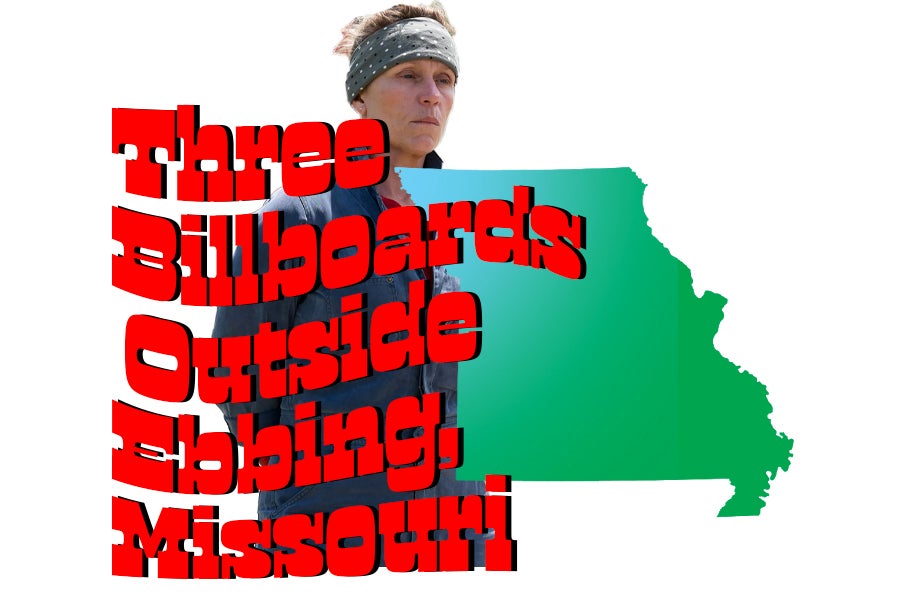
Montana: La Montaña Sagrada (1973). In the interest of picking the best possible “Montana” movie, we’re going to bend the rules a bit here again and go with the Spanish title for the Mexican surrealist filmmaker Alejandro Jodorowsky’s masterpiece The Holy Mountain. A freewheeling, heavily symbolic critique of organized religion, this film defies narrative structure but offers something absolutely amazing to look at in nearly every shot. (Warning: The trailer below is… something.)
Nebraska: Nebraska (2013). Bruce Dern is terrific in this muted black-and-white road picture, playing an ailing, cantankerous old man who reconnects with both his immediate family and his distant relations when he takes a road trip from Montana to Nebraska. This is an alternately funny and touching film, about getting over old regrets and appreciating the now.
Nevada: Nevada Smith (1966). One of the first and oddest examples of a movie prequel, this western recounts the early adventures of a gunslinger who’d previously appeared as a character in the 1964 adaptation of Harold Robbins’ spicy novel The Carpetbaggers. Nevada Smith is an aging legend making a living as an actor in the earlier film, but in the prequel he’s just a vengeful young man, played by Steve McQueen as he was entering the peak of his stardom.
New Hampshire: The Hotel New Hampshire (1984). It’s no easy task to fit all the eccentric characters and crazy twists of a John Irving novel into a single feature film, but writer-director Tony Richardson does an admirable job of capturing both the whimsy and heartbreak in Irving’s book about a big family that runs a small hotel.
New Jersey: New Jersey Drive (1995). One of the best of the post-Boyz n the Hood potboilers about the highs and lows of young gangsters, Nick Gomez’s New Jersey Drive is set in Newark, and concerns a teenage car-theft ring torn apart by law enforcement and their own diverging values. This movie is also proof that Kevin Smith and Zach Braff aren’t the only filmmakers who can tell stories about the Garden State.
New Mexico: In Old New Mexico (1945). The title construction “In Old [insert state name]” was fairly common in the mid-20th century, so it seems wrong not to have at least one example on this list. Let’s go with this zippy “Cisco Kid” western, in which the kind-hearted bandit first kidnaps a woman and then offers to help her out of a jam.
New York: Synecdoche, New York (2008). This will likely be this list’s most controversial choice, because let’s face it: We could fill a big chunk of any larger “best movies named after states” list with just “New York” films. It was tough to decide this one, with Gangs of New York, Escape from New York and King of New York all ripe for the picking. But we’ll never miss a chance to plug one of the 2000s most overlooked and/or misunderstood films: Charlie Kaufman’s visionary and emotionally resonant examination of an acclaimed theater director (played by Philip Seymour Hoffman) who can’t finish his masterpiece because his life and his art keep feeding on each other in increasingly unhealthy ways.
North Carolina: Carolina (2003). It’s true that this movie is set in California and that the “Carolina” is the name of a headstrong young woman (played by Julia Stiles) who was raised by her free-spirited Southern grandma (played by Shirley MacLaine). But the character was born in North Carolina, if that helps. This movie was unfairly buried by its American distributor Miramax, but it’s a lively, woman-centered rom-com, directed by the Oscar-winning Dutch filmmaker Marleen Gorris.
North Dakota: Dakota (1945). Hey, it’s John Wayne again! Here, he plays a gambler who’s planning to settle in Fargo with his savvy new bride, but who first has to track down and outwit the rogues who stole their nest egg.
Ohio: How to Dance in Ohio (2015). This is a wonderful documentary, set in Columbus and following a group of autistic teenagers and young adults who’ve been working on their social skills in therapy, in preparation for a formal dance where they can put what they’ve learned into practice.
Oklahoma: Oklahoma! (1955). Was there ever any doubt here? When it comes to this majestic movie adaptation of a groundbreaking Broadway musical, we’re saying, “You’re doin’ fine Oklahoma! Oklahoma!, you’re O.K.”
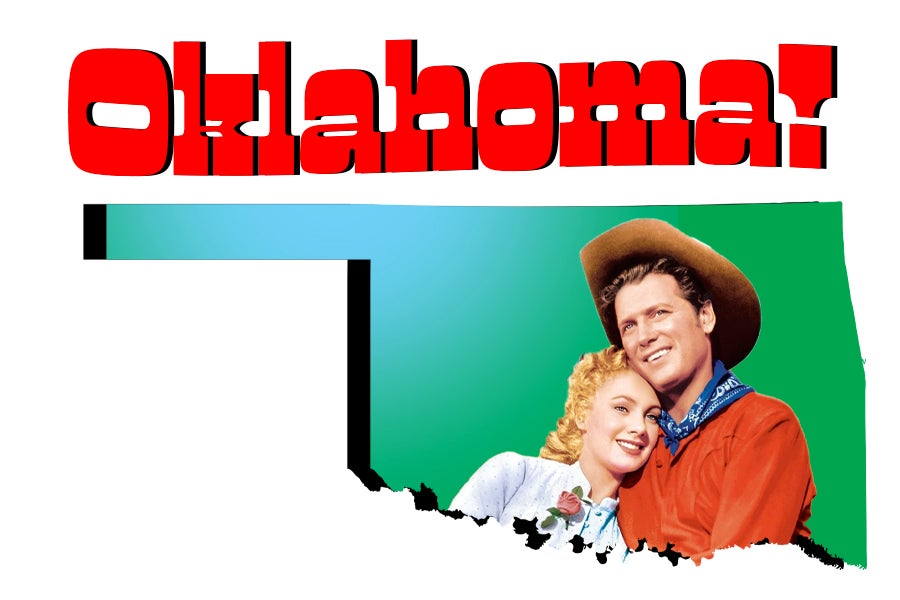
Oregon: How to Die in Oregon (2011). It may seem like we’re leaning heavy on documentaries for this list, but that’s partly a byproduct of one tried-and-true titling pattern for docs. Like westerns, nonfiction films often put states in their names, to suggest a certain historicity. Besides, many of these movies are outstanding, and that includes How to Die in Oregon, a thoughtful look at the public debates and private realities regarding the state’s “Death with Dignity” laws.
Pennsylvania: The Bituminous Coal Queens of Pennsylvania (2005). Yep, it’s another documentary. This slight but genuinely charming film — produced by actress Patricia Heaton and directed by her husband David Hunt — is about a small-town beauty pageant that has been uniting a community and making lasting memories in young ladies’ lives for over 50 years.
Rhode Island: Getting Out of Rhode Island (2003). There aren’t a lot of “Rhode Island” movies out there (or even “Rhode” movies… unless we want to really stretch and go with The Colossus of Rhodes). But this no-budget oddity from regional filmmaker Christian de Rezendes will suit. Its shot-on-the-fly, you-are-there depiction of old friends reuniting for a boozy, woozy party features plenty of local flavor.
South Carolina: Bastard Out of Carolina (1996). We’re cheating again on the second of our “Carolina” movies, though at least this time the story is set in the state we’re picking it to represent. Director Anjelica Huston and screenwriter Anne Meredith deliver an impressively sensitive and artful made-for-cable adaptation of Dorothy Allison’s acclaimed novel, about a young mother (played by Jennifer Jason Leigh) trying to raise a daughter born out of wedlock in 1950s Greenville, while dealing with ostracism and an abusive monster of a second husband.
South Dakota: Dakota Incident (1956). For fans of westerns, the 1950s were a boom-time, with both the local movie houses and TV screens filled with briskly paced, visually appealing and often psychologically complex tales of frontier life. Dakota Incident isn’t one of the better-known films from this era, but it’s a taut and crafty picture, about a stagecoach filled with eclectic characters, arguing about the best way to survive their journey through hostile territory.
Tennessee: Tennessee Johnson (1942). We were tempted to pick a real wild card here and go with the dearly departed director Jonathan Demme’s last major project: the thrilling concert film Justin Timberlake + the Tennessee Kids. But we’ll skew a bit more traditional instead, and select this whitewashed but fascinating biopic of President Andrew Johnson, who in the movies — if not in real life — oversees a period of national healing after the Civil War and the assassination of Abraham Lincoln.
Texas: The Texas Chain Saw Massacre (1974). The classy option here would be Wim Wenders’ mesmerizing 1984 art film Paris, Texas, written by Sam Shepard with L.M. Kit Carson. But the right choice is the movie with “chain saw” in the title (broken into two words in the original version). A terrifying and grubby exploitation classic, The Texas Chain Saw Massacre is both viscerally exciting and subtly satirical, mocking the curious customs and “freedoms” of rural Texans. Director Tobe Hooper would make his message even clearer in the underrated sequel, The Texas Chainsaw Massacre 2 — written by, believe it or not, L.M. Kit Carson.
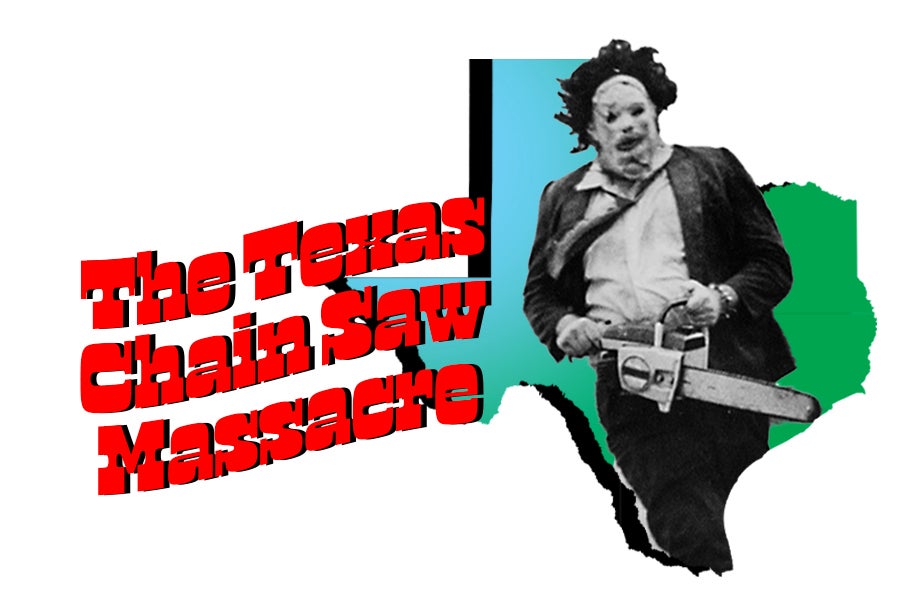
Utah: Utah (1945). We could’ve gone with John Wayne again, and picked one of his earliest films: 1934’s The Man from Utah. But let’s get Roy Rogers onto the list instead, with one of the movies from his heyday, featuring Dale Evans, Trigger and the Sons of the Pioneers.
Vermont: Moonlight in Vermont (2017). It probably says something about Vermont’s place in the contemporary American consciousness that there’s been a surge in TV movies with “Vermont” in the title over the past few years, and that nearly all of them are romantic comedies about harried professionals who find love and reconnect with what matters when they visit a quaint small town. Moonlight in Vermont is typical of the genre: a light-hearted romp starring Lacey Chabert as a woman who straightens her life out in front of a backdrop of cozy inns and dazzling foliage.
Virginia: Who’s Afraid of Virginia Woolf? (1966). The writer Virginia Woolf was English and director Mike Nichols’ movie adaptation of Edward Albee’s Tony-winning play is set at a New England college. Nevertheless, this is the best “Virginia” film: a still-shocking psychodrama about drunken academics ripping apart the foundational lies of their marriages and careers over the course of one brutally honest night of drinking and “games.”
Washington: Mr. Smith Goes to Washington (1939). It’s undoubtedly unfair to the state of Washington that nearly every viable film with its name in the title is about the city in D.C. But it’s also unfair to the District of Columbia that it doesn’t have all the rights afforded to a state. Anyway, they’re both named for the same ex-president, who himself is a hero to the teacher-turned-senator Jefferson Smith in director Frank Capra’s stirring patriotic dramedy.
West Virginia: The Wild and Wonderful Whites of West Virginia (2009). Here’s another worthy documentary, about how one sprawling underclass family survives in the hills of Boone County — through a combination of odd jobs, ill-advised stunts and criminal enterprise. It’s not the most flattering depiction of the region, but it’s entertaining and refreshingly frank.
Wisconsin: Wisconsin Death Trip (1999). Sorry, Wisconsin; we’re sure you’d rather be recognized for a genteel Midwestern comedy or some paean to radical leftist politics. But you should be proud of this unflinching slice-of-life doc — even if it was directed by an Englishman, James Marsh. Adapting a book of found photographs from the late 19th century, Wisconsin Death Trip uncovers the hardship, violence and madness that defined a lot of rural life in the decades after the Civil War.
Wyoming: Green Grass of Wyoming (1948). Once again, we have to note how odd it is that it’s hard to find a good movie for “Massachusetts,” and yet “Wyoming” has been part of the name of at least two dozen feature films. Nearly all of them are westerns, and none are particularly excellent. So let’s end on something a little different: a horse-racing melodrama that was part of the popular My Friend Flicka series. The story is simple but the scenery is spectacular in this movie about life on a ranch, in one of America’s most picturesque states. We salute you, Wyoming: last in the alphabetical listings, but not last in our hearts.
